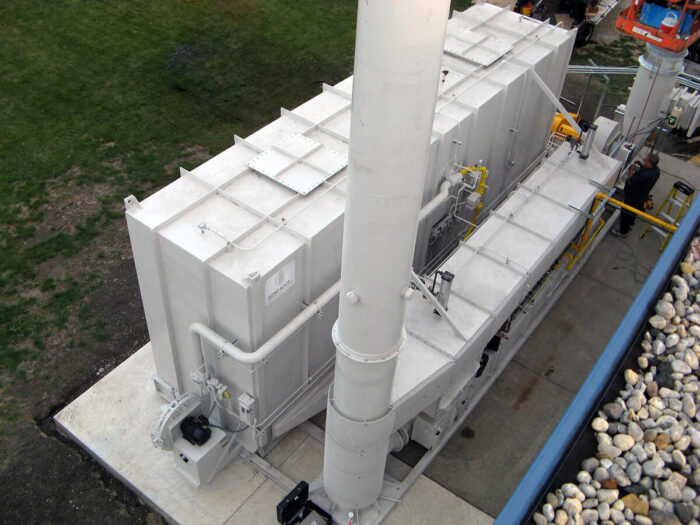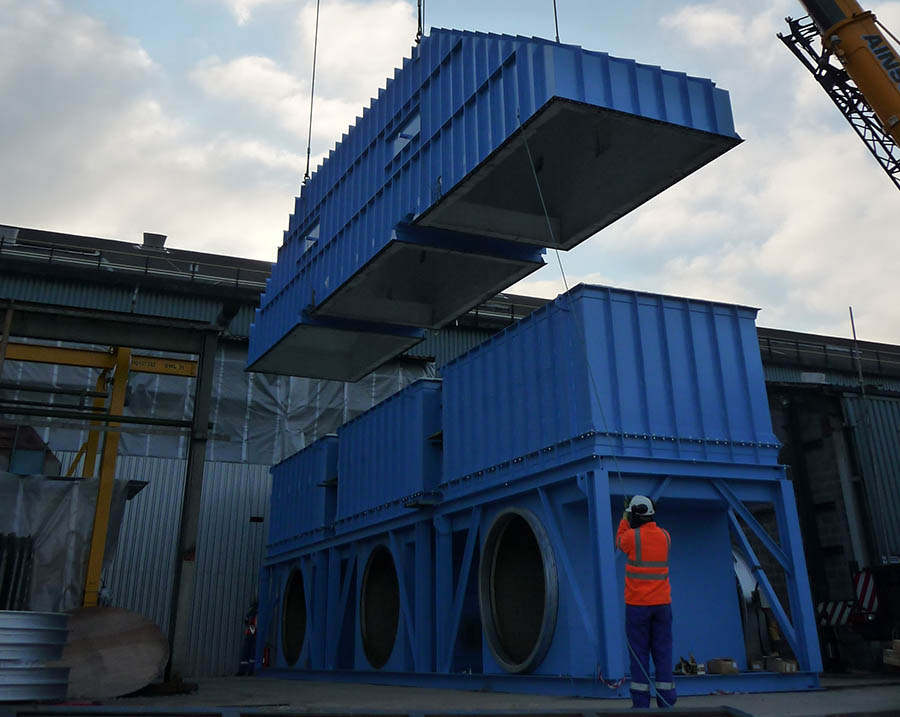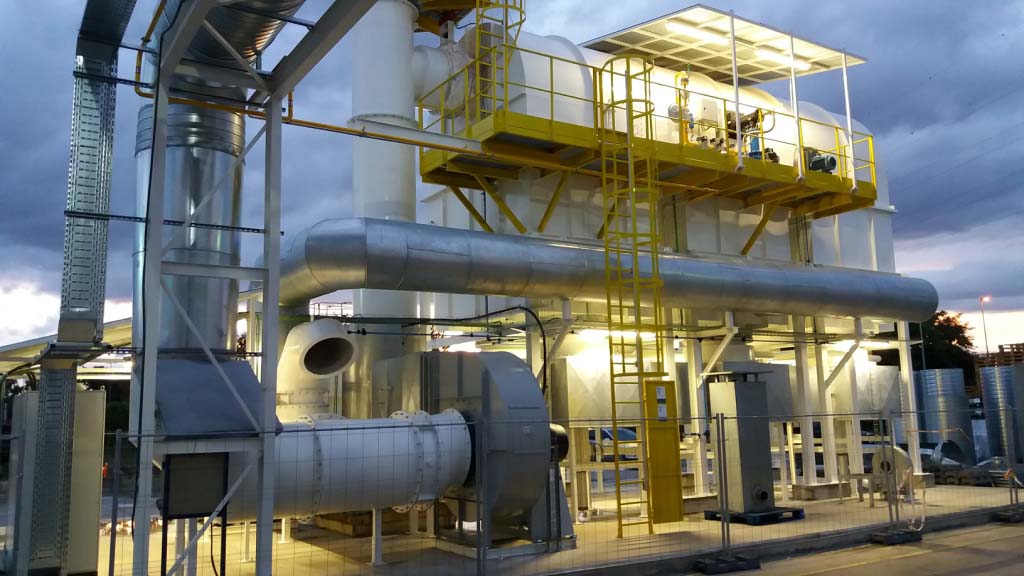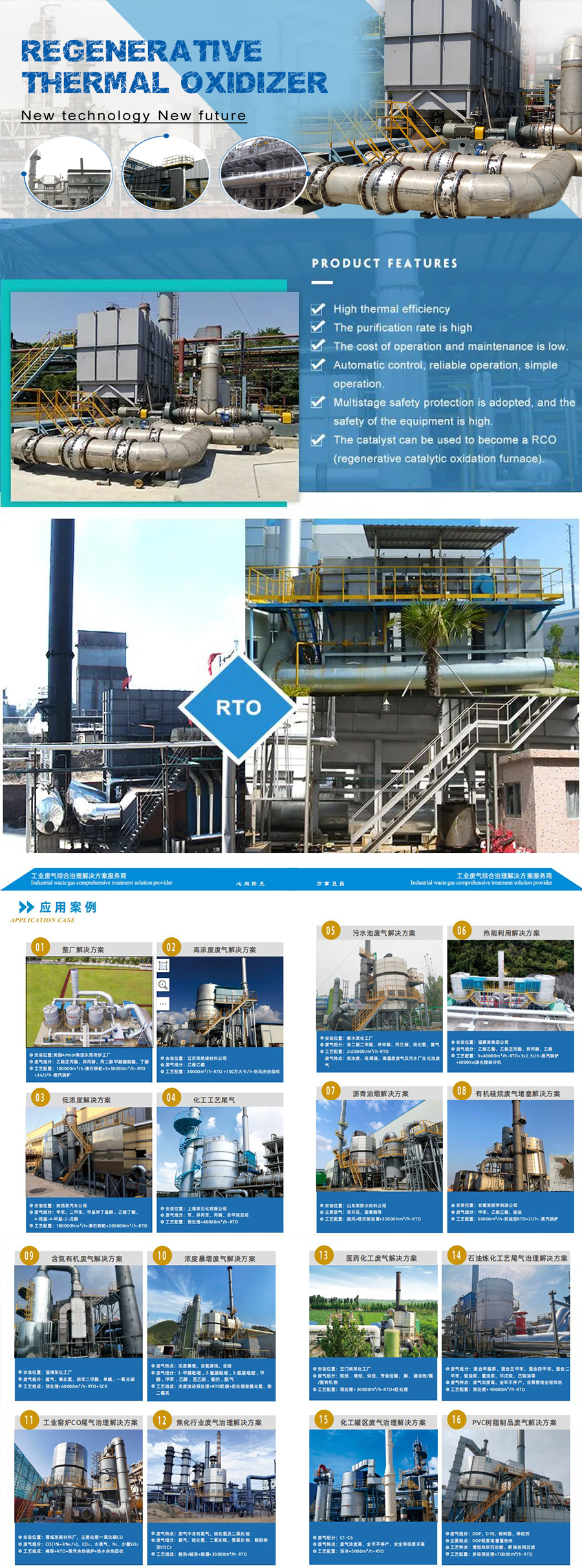基本訊息
型號
Amazing RTO
類型
Incinerator
Energy Saving
100
Easy for Operation
100
High Efficiency
100
Less Maintenance
100
商標
Bjamazing
運輸套餐
Overseas Wooden
Specification
180*24
起源
China
HS Code
8416100000
產品描述
RTO
蓄熱式熱氧化器
Compared with traditional catalytic combustion,; direct thermal oxidizer,; RTO has the merits of high heating efficiency,; low operation cost,; and the ability to treat large flux low concentration waste gas.; When VOCs concentration is high,; secondary heat recycle can be realized,; which will greatly reduce the operation cost.; Because RTO can preheat the waste gas by levels through ceramic heat accumulator,; which could make the waste gas to be completely heated and cracked with no dead corner(treatment efficiency>99%);,;which reduce the NOX in the Exhausting gas,; if the VOC density >1500mg/Nm3,; when the waste gas reach cracking area,; it has been heated up to cracking temperature by heat accumulator,; the burner will be closed under this condition.;
RTO can be devided into chamber type and rotary type according to difference operation mode.; Rotary type RTO has advantages in system pressure,; temperature stability,; investment amount,; etc
| RTO types | Efficiency | Pressure change (mmAq); | 尺寸 | (max);Treatment volume | |
| Treatment efficiency | Heat recycle efficiency | ||||
| Rotary type RTO | 99 % | 97 % | 0-4 | small(1 time); | 50000Nm3/h |
| Three chamber type RTO | 99 % | 97 % | 0-10 | Large (1.;5times); | 100000Nm3/h |
| Two chamber type RTO | 95 % | 95 % | 0-20 | middle(1.;2times); | 100000Nm3/h |
Regenerative Thermal Oxidizer,; Regenerative Thermal Oxidizer,; Regenerative Thermal Oxidizer,; Thermal Oxidizer,; Thermal Oxidizer,; Thermal Oxidizer,; oxidizer,; oxidizer,; oxidizer,; incinerator,; incinerator,; incinerator,; waste gas treatment,; waste gas treatment,; waste gas treatment,; VOC treatment,; VOC treatment,; VOC treatment,; RTO,; RTO,; RTO,; RTO,; RTO,; RTO
Address: 8 floor, E1, Pinwei building, Dishengxi road, Yizhuang, ZheJiang , China
業務類型: 製造商/工廠, 貿易公司
Business Range: Electrical & Electronics, Industrial Equipment & Components, Manufacturing & Processing Machinery, Metallurgy, Mineral & Energy
Management System Certification: ISO 9001, ISO 14001
Main Products: Rto, Color Coating Line, Galvanizing Line, Air Knife, Spares for Processing Line, Coater, Independent Equipments, Sink Roll, Revamping Project, Blower
Company Introduction: ZheJiang Amazing Science & Technology Co., Ltd is a thriving Hi-tech company, located in ZheJiang Economic and Technological Development Area(BDA). Adhering to the concept of Realistic, Innovative, Focused and Efficient, our company mainly serve the waste gas treatment (VOCs) Industry and metallurgical equipment of China and even whole world. We have advanced technology and rich experience in VOCs waste gas treatment project, the reference of which has been successfully applied to the industry of coating, rubber, electronic, printing, etc. We also have years of technology accumulation in the research and manufacturing of flat steel processing line, and possess nearly 100 of application example.
Our company focus on the research, design, manufacturing, installation and commissioning of VOCs organic waste gas treatment system and the revamping and updating project for energy saving and environmental protection of flat steel processing line. We can provide customers the complete solutions for environmental protection, energy saving, product quality improvement and other aspects.
We are also engaged in various spares and independent equipment for color coating line, galvanizing line, pickling line, like roller, coupler, heat exchanger, recuperator, air knife, blower, welder, tension leveler, skin pass, expansion joint, shear, jointer, stitcher, burner, radiant tube, gear motor, reducer, etc.

What is the cost of installing a regenerative thermal oxidizer?
The cost of installing a regenerative thermal oxidizer (RTO) can vary significantly depending on several factors. These factors include the size and capacity of the RTO, the specific requirements of the application, site conditions, and any additional customization or engineering needed. However, it’s important to note that RTOs are generally considered a significant capital investment due to their complex design and high-performance capabilities.
Here are some cost considerations associated with installing an RTO:
- RTO Size and Capacity: The size and capacity of the RTO, typically measured in terms of exhaust flow rate and pollutant concentration, are important cost factors. Larger RTOs capable of handling higher exhaust volumes and pollutant concentrations generally have higher upfront costs compared to smaller units.
- Engineering and Customization: The engineering and customization requirements for integrating the RTO into the existing industrial process can impact the installation cost. This includes factors such as ductwork modifications, electrical connections, and any necessary process integration to ensure proper functioning of the RTO within the overall system.
- Site Preparation: The site where the RTO will be installed may require preparation to accommodate the equipment. This can involve constructing foundations, providing adequate space for the RTO and associated components, and ensuring proper access for installation and maintenance.
- Auxiliary Systems and Equipment: In addition to the RTO itself, there may be auxiliary systems and equipment required for effective operation. This can include pre-treatment systems, such as scrubbers or filters, heat recovery units, monitoring and control systems, and stack emissions monitoring equipment. The cost of these additional components should be considered in the overall installation cost.
- Installation Labor and Equipment: The cost of labor and equipment required for the installation process, including crane services and specialized contractors, should be factored into the overall cost. The complexity of the installation and any specific site challenges can influence these costs.
- Permits and Compliance: Obtaining necessary permits and complying with regulatory requirements can involve additional costs. This includes fees for environmental permits, engineering studies, emissions testing, and compliance documentation.
Due to the many variables involved, it is challenging to provide a specific cost range for installing an RTO. It is recommended to consult with reputable RTO manufacturers or engineering firms, who can assess the specific requirements of the application and provide detailed cost estimates based on the project scope.

Are regenerative thermal oxidizers safe to operate?
Regenerative thermal oxidizers (RTOs) are designed with safety considerations to ensure their safe operation. When properly installed, operated, and maintained, RTOs provide a high level of safety. Here are some key points regarding the safety of operating RTOs:
- Combustion and Fire Safety: RTOs are designed to safely combust and destroy volatile organic compounds (VOCs) and other pollutants in the exhaust stream. They incorporate various safety features to prevent the risk of uncontrolled fires or explosions. These features may include flame arrestors, temperature sensors, pressure relief devices, and automated shutdown systems to ensure safe operation in the event of abnormal operating conditions.
- Control and Monitoring Systems: RTOs are equipped with advanced control and monitoring systems that continuously monitor various parameters such as temperature, pressure, and flow rates. These systems provide real-time data to operators, allowing them to detect any deviations from normal operating conditions promptly. Alarms and safety interlocks are often included to alert operators and initiate appropriate actions in case of abnormal situations.
- Heat Recovery and Thermal Efficiency: RTOs are designed to maximize thermal efficiency by recovering and reusing heat generated during the oxidization process. This reduces the overall energy consumption and minimizes the risk of heat buildup within the system, contributing to safe operation and preventing excessive temperatures that could pose safety hazards.
- Equipment and Material Selection: RTOs are constructed using materials that can withstand the high temperatures and corrosive conditions encountered during operation. Heat-resistant materials, such as ceramic beds or metallic heat exchangers, are commonly used. Proper material selection ensures the integrity and longevity of the equipment, reducing the risk of failures or leaks that could compromise safety.
- Compliance with Standards and Regulations: RTOs must comply with applicable safety standards and regulations. These standards define specific requirements for the design, installation, operation, and maintenance of air pollution control systems, including RTOs. Compliance with these standards ensures that the RTOs meet the necessary safety criteria and helps safeguard the health and well-being of personnel and the surrounding environment.
- Operator Training and Maintenance: Adequate operator training and regular maintenance are crucial for safe RTO operation. Operators should receive comprehensive training on the system’s operation, safety procedures, and emergency response protocols. Additionally, routine maintenance and inspections help identify and address any potential safety concerns or equipment issues before they escalate.
While RTOs are generally safe to operate, it is essential to follow the manufacturer’s guidelines, maintain proper safety protocols, and adhere to applicable regulations to ensure safe and reliable operation.

How efficient are regenerative thermal oxidizers in destroying volatile organic compounds (VOCs)?
Regenerative thermal oxidizers (RTOs) are highly efficient in destroying volatile organic compounds (VOCs) emitted from industrial processes. Here are the reasons why RTOs are considered efficient in VOC destruction:
1. High Destruction Efficiency: RTOs are known for their high destruction efficiency, typically exceeding 99%. They effectively oxidize VOCs present in the industrial exhaust streams, converting them into less harmful byproducts, such as carbon dioxide and water vapor. This high destruction efficiency ensures that the majority of VOCs are eliminated, resulting in cleaner emissions and compliance with environmental regulations.
2. Residence Time: RTOs provide a sufficiently long residence time for the combustion of VOCs. In the RTO chamber, the VOC-laden air is directed through a ceramic media bed, which acts as a heat sink. The VOCs are heated to the combustion temperature and react with the available oxygen, leading to their destruction. The design of RTOs ensures that the VOCs have ample time to undergo complete combustion before being released into the atmosphere.
3. Temperature Control: RTOs maintain the combustion temperature within a specific range to optimize VOC destruction. The operating temperature is carefully controlled based on factors such as the type of VOCs, their concentration, and the specific requirements of the industrial process. By controlling the temperature, RTOs ensure that the VOCs are efficiently oxidized, maximizing destruction efficiency while minimizing the formation of harmful byproducts, such as nitrogen oxides (NOx).
4. Heat Recovery: RTOs incorporate a regenerative heat recovery system, which enhances their overall energy efficiency. The system captures and preheats the incoming process air by utilizing the heat energy from the outgoing exhaust stream. This heat recovery mechanism minimizes the amount of external fuel required to sustain the combustion temperature, resulting in energy savings and cost-effectiveness. The heat recovery also helps maintain the high destruction efficiency of VOCs by providing a consistent and optimized operating temperature.
5. Catalyst Integration: In some cases, RTOs can be equipped with catalyst beds to further enhance VOC destruction efficiency. Catalysts can accelerate the oxidation process and lower the required operating temperature, improving the overall efficiency of VOC destruction. Catalyst integration is particularly beneficial for processes with lower VOC concentrations or when specific VOCs require lower temperatures for effective oxidation.
6. Compliance with Regulations: The high destruction efficiency of RTOs ensures compliance with environmental regulations governing VOC emissions. Many industrial sectors are subject to stringent air quality standards and emission limits. RTOs provide an effective solution for meeting these requirements by reliably and efficiently destroying VOCs, reducing their impact on air quality and public health.
In summary, regenerative thermal oxidizers (RTOs) are highly efficient in destroying volatile organic compounds (VOCs). Their high destruction efficiency, residence time, temperature control, heat recovery capabilities, optional catalyst integration, and compliance with regulations make RTOs a preferred choice for industries seeking effective and sustainable solutions for VOC abatement.

editor by Dream 2024-11-27
